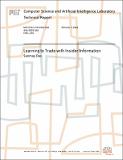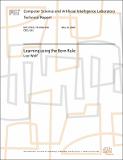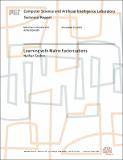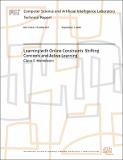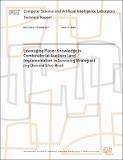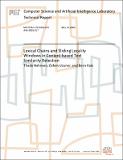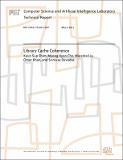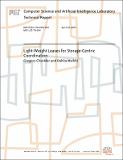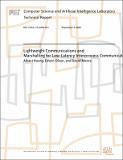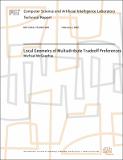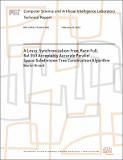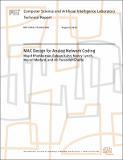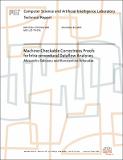Browsing CSAIL Digital Archive by Title
Now showing items 401-420 of 806
-
Learning Semantic Scene Models by Trajectory Analysis
(2006-02-10)In this paper, we describe an unsupervised learning framework to segment a scene into semantic regions and to build semantic scene models from long-term observations of moving objects in the scene. First, we introduce two ... -
Learning Solutions of Similar Linear Programming Problems using Boosting Trees
(2010-09-18)In many optimization problems, similar linear programming (LP) problems occur in the nodes of the branch and bound trees that are used to solve integer (mixed or pure, deterministic or stochastic) programming problems. ... -
Learning to Trade with Insider Information
(2005-10-07)This paper introduces algorithms for learning how to trade usinginsider (superior) information in Kyle's model of financial markets.Prior results in finance theory relied on the insider having perfectknowledge of the ... -
Learning using the Born Rule
(2006-05-16)In Quantum Mechanics the transition from a deterministic descriptionto a probabilistic one is done using a simple rule termed the Bornrule. This rule states that the probability of an outcome ($a$)given a state ($\Psi$) ... -
Learning with Matrix Factorizations
(2004-11-22)Matrices that can be factored into a product of two simpler matricescan serve as a useful and often natural model in the analysis oftabulated or high-dimensional data. Models based on matrixfactorization (Factor Analysis, ... -
Learning with Online Constraints: Shifting Concepts and Active Learning
(2006-09-01)Many practical problems such as forecasting, real-time decisionmaking, streaming data applications, and resource-constrainedlearning, can be modeled as learning with online constraints. Thisthesis is concerned with analyzing ... -
The Levels of Understanding framework, revised
(2012-05-31)I discuss the "levels of understanding" framework described in Marr's Vision and propose a revised and updated version of it to capture the changes in computation and neuroscience over the last 30 years. -
Lexical Chains and Sliding Locality Windows in Content-based Text Similarity Detection
(2005-05-19)We present a system to determine content similarity of documents. More specifically, our goal is to identify book chapters that are translations of the same original chapter; this task requires identification of not only ... -
LIBPMK: A Pyramid Match Toolkit
(2008-04-07)LIBPMK is a C++ implementation of Grauman and Darrell's pyramid match algorithm. This toolkit provides a flexible framework with which developers can quickly match sets of image features and run experiments. LIBPMK provides ... -
Library Cache Coherence
(2011-05-02)Directory-based cache coherence is a popular mechanism for chip multiprocessors and multicores. The directory protocol, however, requires multicast for invalidation messages and the collection of acknowledgement messages, ... -
Light-Weight Leases for Storage-Centric Coordination
(2004-04-22)We propose light-weight lease primitives to leverage fault-tolerant coordination among clients accessing a shared storage infrastructure (such as network attached disks or storage servers). In our approach, leases are ... -
Lightweight Communications and Marshalling for Low-Latency Interprocess Communication
(2009-09-02)We describe the Lightweight Communications and Marshalling (LCM) library for message passing and data marshalling. The primary goal of LCM is to simplify the development of low-latency message passing systems, targeted at ... -
Local Geometry of Multiattribute Tradeoff Preferences
(2007-02-01)Existing preference reasoning systems have been successful insimple domains. Broader success requires more natural and moreexpressive preference representations. This thesis develops arepresentation of logical preferences ... -
Long-Lived Rambo: Trading Knowledge for Communication
(2004-04-12)Shareable data services providing consistency guarantees, such as atomicity (linearizability), make building distributedsystems easier. However, combining linearizability with efficiency in practical algorithms is difficult. ... -
A Lossy, Synchronization-Free, Race-Full, But Still Acceptably Accurate Parallel Space-Subdivision Tree Construction Algorithm
(2012-02-23)We present a new synchronization-free space-subdivision tree construction algorithm. Despite data races, this algorithm produces trees that are consistent enough for the client Barnes-Hut center of mass and force computation ... -
M&M: A Passive Toolkit for Measuring, Correlating, and Tracking Path Characteristics
(2004-04-14)This paper presents M&M, a passive measurement toolkitsuitable for large-scale studies of Internet path characteristics.The multiQ tool uses equally-spaced mode gaps in TCP flowsÂ’packet interarrival time distributions to ... -
MAC Design for Analog Network Coding
(2010-08-02)Most medium access control mechanisms discard collided packets and consider interference harmful. Recent work on Analog Network Coding (ANC) suggests a different approach, in which multiple interfering transmissions are ... -
Machine-Checkable Correctness Proofs forIntra-procedural Dataflow Analyses
(2004-12-16)This technical report describes our experience using the interactive theorem proverAthena for proving the correctness of abstract interpretation-based dataflow analyses.For each analysis, our methodology requires the ...


